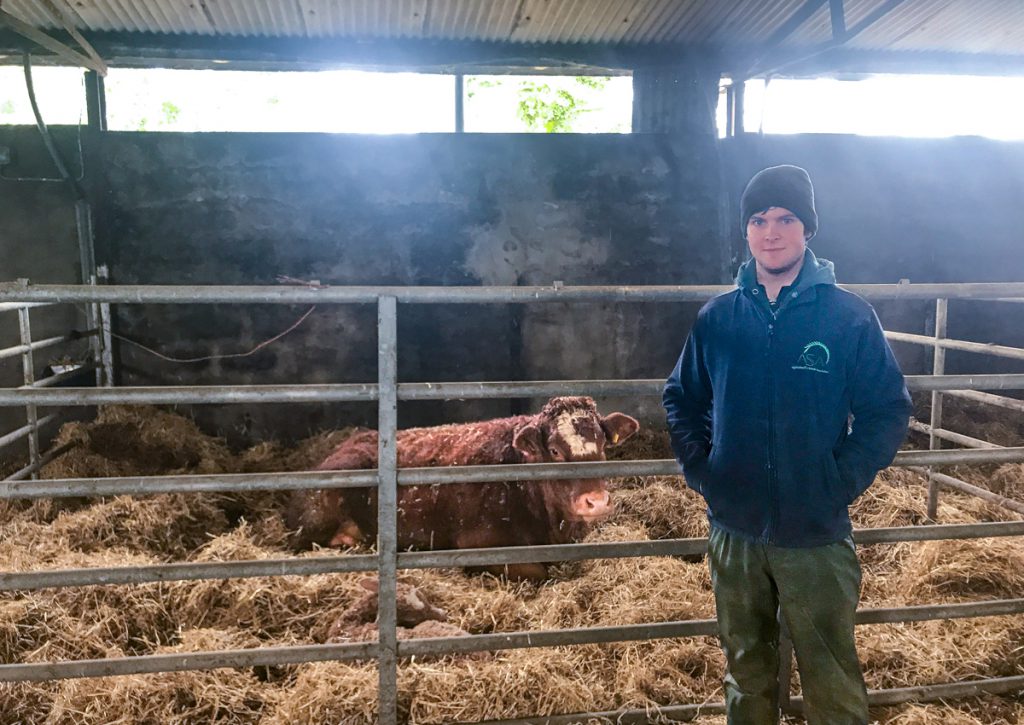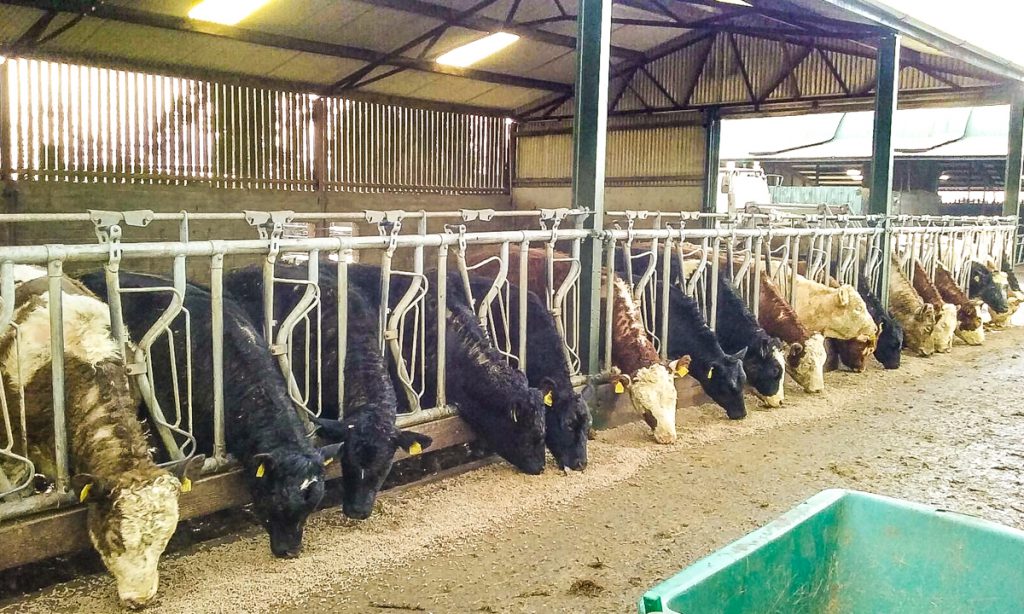Farming in Bartstown, Newbridge, Co. Kildare, Darragh Barron runs a suckler-to-beef enterprise on 30% owned land and 70% rented land.
A graduate of UCD’s Animal and Crop Production degree programme, he runs a herd of 50 Limousin, Simmental and Angus spring-calving cows. Heifers are kept as replacements, as Darragh hopes to expand his herd to 85-90 cows over the next few years.
The home farm stretches across 50ac and is home to the finishing cattle. The suckler herd is located on the rented out farm, located approximately 15 minutes away.
“I’m not afraid to expand my herd. I’m still making money from it so I don’t see why not. There’s no point jumping off the boat too quick,” he explained.
When you don’t own land and you want to farm, you may bite the bullet and go for it.
“I have the land on a long-term lease so I’m able to plan to some extent. The only thing is that the money has left your account before you do anything,” Darragh added.
The Kildare-based farmer also scooped the under-23, Young Farmer of the Year 2017 award last November.
On this, he said: “I wasn’t expecting to get anywhere near the final. It was great. I met a lot of other farmers at it. And, I suppose, it showed that I wasn’t doing too bad of a job here either,” he explained.
The system
Darragh aims to finish all bulls under 16 months. Weanling bulls are also bought in and finished off grass at 19 months.
“All the cattle are finished on the home farm and the cows are kept on the out farm. I try not to mix any of the animals that are bought in,” he explained.
All replacement heifers are bred on the farm. Any heifers which don’t make the grade will also be finished off grass. The 50-cow herd is expected to calve, along with 25 replacement heifers, over the next six weeks.
He said: “The average age of the herd is very young and over 50% of the herd are second calvers. The only reason why a cow will be culled is if she doesn’t go in calf.”
The farm is home to three stock bulls – two Limousin and one Simmental. The bulls are described as easy calving and have an average calving difficulty score of 4.4%.
Recently, Darragh has also started to manage a suckler-to-weanling enterprise, which is located 15 minutes from his own farm. This farm is home to a 70 cow, spring-calving herd. The majority of the herd is Limousin with three stock bulls – a Charolais, a Limousin and a Simmental.
“I also milk in the mornings for another farmer, but that’s as much as I like to do with them. I do five mornings per week and every second weekend,” he added.
Calving and Breeding
Calving (on his own farm) is expected to start over the coming days and will last approximately six weeks.
“I try and keep the interval as tight as possible. Because I work away on another farm, I can’t be in two places at once. I don’t want to be hanging around for two or three cows to calve,” he explained.
“I like to calve my own cows in a group. I don’t really believe in having a cow in a pen for two or three days watching her. As they come close to calving, I will group them in sixes or sevens and put them in individual pens as they calve.
When one cow would calve, I think other cows get anxious to calve also. It nearly gets them in the mood if that makes sense.
Both cows and heifers calve down at 24 months. The bull will be let out with the cows on May 10 and let run with the herd until June 25.
“The trick with breeding replacements heifers at 15 months is to get them out to grass early. They get fed well over the winter too. They get 2.5kg of meal and the best of silage. Once they are up on 360-370kg coming out of the shed, you will get them there,” Darragh explained.
Replacements are bred at 400-420kg and will calve down at 500-600kg – depending on breed. This year, he hopes to synchronise all replacement heifers and use easy-calving Limousin straws.
Feeding and finishing
The cows are fed a silage-based diet, which has a dry matter digestibility (DMD) of 75%. However, the cows receive straw every third day. Six weeks prior to calving, pre-calving minerals are fed in the form of a silage dusting. They also receive a high-iodine bolus prior to calving.
“Last year, I fed the cows a little too well and I had a few difficulties; they were in too good of order. The quality of the silage was excellent. However, it was too late when I realised and I didn’t want to start restricting their diet then.”
He continued: “But look, you learn from your mistakes and I have them in better condition this year. I body condition score (BCS) three times throughout the winter. Anytime I’m doing anything with them, like vaccinations, I would give them a quick score.
“I go a little bit stronger with the pre-calving mineral to ensure that each cow gets enough. The calves will be good and lively; the cow will clean off well after calving and will have good amounts of colostrum as a result of the pre-calver,” Darragh added.
Calves are weaned in the last two weeks of October weighing approximately 360-430kg.
Darragh weighs his weanling coming off the cow and once a month until slaughter. He said: “It’s the only way you can tell what’s going on.
“All the animals will be weighed pre-slaughter, but I would also check their fat cover around the tail, cod and around the ribs. When your at it everyday, you kind of get an eye for it,” he added.
The bulls are then housed and fed a starter diet. This is a 16% protein diet which contains: flaked maize; flaked barley; sugar beet; and soya oil. They also receive silage and straw on alternating days.
They are fed this until they hit 500kg. The ration is fed at a rate of 2kg/head/day. It is increased to 3.5-4kg/head/day before the animals are switched to a finisher ration. The bulls have an average daily gain (ADG) of 1-1.25kg/day on this ration.
The finisher diet is a ‘15% super beef nut’ ration . On this, he said: “I was feeding them a coarse ration before. However, since switching to the nut, I seem to be getting flesh on the bulls at a younger age compared to the ration.”
The Simmental bulls are slaughtered at a weight of 720kg (liveweight), while the Limousines are killed weighing 700kg (liveweight).
New buildings to cope with expansion
To facilitate expansion, Darragh has built on to an existing straw-bedded shed. A 75ft long, 12.6ft wide and 8ft deep tank was installed.
“I built on to an existing shed during the back end of last year. Originally, it was a loose straw house and I put a tank in front of the lie-back area. The cattle stand out onto the slats to feed,” he explained.
“I find the cattle are very healthy. I don’t think I will ever roof it. There is super ventilation throughout the shed.
“You could come out on the coldest night and the fattening bulls would be lying on the slats and a bed of straw inside waiting for them. Even if it was raining, they could be standing on the slats,” he explained.
Darragh not only has his eye set on new buildings. He also explained that if any additional land was to come up for lease, he would expand some more.
“If another farm came up for lease, I’d have another go at it. I don’t thing I’d expand the cows, but I would drive on the beef side of the business,” he explained.
Joined up thinking needed between dairy and beef
Darragh gave his opinion on the beef industry here in Ireland and remained upbeat about the potential to keep producing quality beef.
“I see a future in it and I’m not going to throw in the towel yet. There has to be a market for the quality cattle. They have spent years building up the trade links, it can’t just go overnight.
“A lot of the dairy-origin stock are not meeting market specifications. I’ts hard to make an animal into something they are not,” he explained.
“If they start paying us for the yield of meat that they are getting, it would be a fairer job also. There is definitely scope for an increase. They are mad keen for cattle, but yet they are not willing to pay for them.
It has to stay around the 400c/kg mark. You need that to make a profit.
On the live exports, he said: “If they can keep shipping these calves it would be a great job. However, this will lead to more competition for the good-quality weanlings.
“I don’t think anyone who has switched to calf-to-beef system will come back over to the continental side. The gap is too far for them to get back into the numbers,” he added.
“There is definitely joined-up thinking needed between the dairy and beef industry in Ireland. They need to start using proper beef bulls.”
Young Beef Farmer Sustainability Programme
Darragh is involved in the Young Beef Farmer Sustainability Programme (YBFSP) in conjunction with Macra na Feirme and Dawn Meats.
The programme is designed to help young farmers to develop their farming skills and their business and commercial awareness. There are 15 other young farmers in the discussion group.
“The discussion group is great. It is not even the learning part of it; it’s more the competitive part that I enjoy. You can compare yourself with your peers and set yourself against someone.
It’s all about healthy competition, which will help you to reach your targets.
Darragh is also involved in a Teagasc Knowledge Transfer discussion group.
“I see one big thing with discussion groups and farm walks. People seem to be mad for information, but they don’t always use it. They nearly want someone to come out and do it for them,” he concluded.








